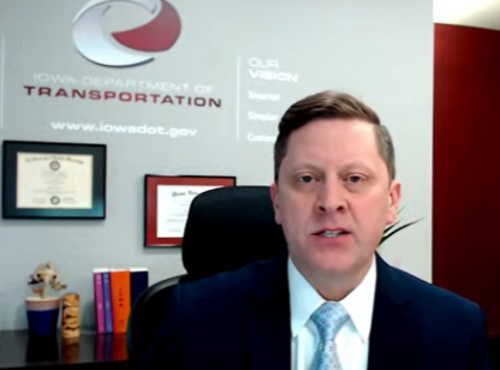A February 2 hearing on Capitol Hill examined the potential role connected and automated vehicles or CAVs could play in terms of improving transportation safety, equity, and sustainability.
Scott Marler (seen above), director of the Iowa Department of Transportation, was one of eight witnesses testifying before the Highways and Transit Subcommittee of the House of Representatives Transportation & Infrastructure Committee.
His comments reflected the position of the American Association of State Highway and Transportation Officials and state departments of transportation nationwide on the future benefits of CAVs.
Marler is also chair of the AASHTO Committee on Transportation System Operations and serves on the Cooperative Automated Transportation Coalition – a partnership between AASHTO, Intelligent Transportation Society of America, Institute of Transportation Engineers, and the Federal Highway Administration.
“I firmly believe, as do the other state DOTs, that the deployment of CAVs will greatly improve the safety, equity, and sustainability of the nation’s transportation system,” Marler explained in his written testimony.

“CAVs represent an important part of a multimodal transportation ecosystem, which we broadly refer to as cooperative automated transportation, with a focus on integrating connected and automated vehicle technologies for all existing and emerging modes of surface transportation,” he added.
“Iowa, like all state DOTs, are infrastructure owners and operators (IOOs) that play a fundamental role in advancing, operating, and maintaining the physical and digital infrastructure necessary to support intelligent transportation systems,” Marler pointed out.
“The state DOTs have been focused on preparing for a more automated future, a term we call ‘readiness,’ by focusing on interoperable, reliable, and consistent infrastructure – both physical and digital – [along with] a cohesive vision, collaborative partnerships, funding, and clear policy,” he said.
AASHTO recently released a new video that outlines the organization’s key policy principles where connected and automated vehicles or CAVs are concerned.
Building off an eight-page policy paper AASHTO issued ahead of its 2021 annual meeting, the video – entitled “Connecting on CAVs” – explores the 10 principles espoused by the organization to help advance the development of CAV technology.
Marler emphasized at the hearing that while state DOTs are preparing for the deployment of CAVs down the road, there remains “a lot of uncertainty” in terms of what that future would ultimately look like.
“The path and timeline to deployment is unclear for many different reasons with the CAV industry continuing to evolve, consolidate, and change on an almost daily basis,” he explained.

“Steadfast to these uncertainties is the fact that state DOTs, as critical surface transportation IOOs, are absolutely dedicated to supporting the safe deployment of a connected, automated, and cooperative vehicle ecosystem where benefits are seen across all of the states and throughout the population,” he added.
Marler pointed out that “numerous challenges” remain ranging from “the technological to economic to political,” where CAVs are concerned. “These are significant challenges, but ones that we can overcome as an industry if we all work together,” he said.
“Thus, we need the federal government as an integral partner. We need the technology developers, vehicle manufacturers, and IOOs collaborating with each other to get the safety technology deployed,” Marler added. “We need the IOOs at the state and local level to ensure equity in how the technology gets used. Finally, we need to work together to determine how deployment will be funded.”



